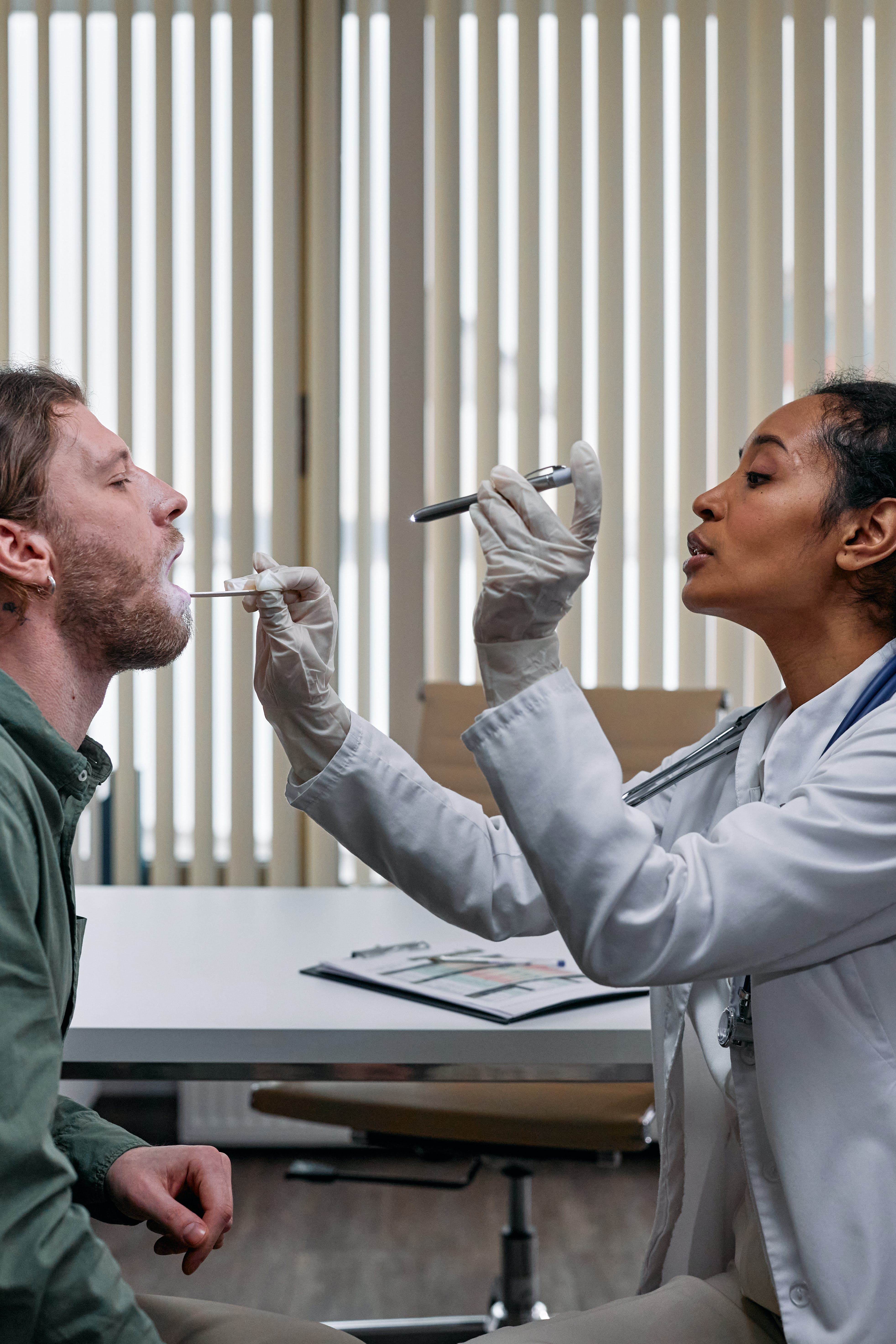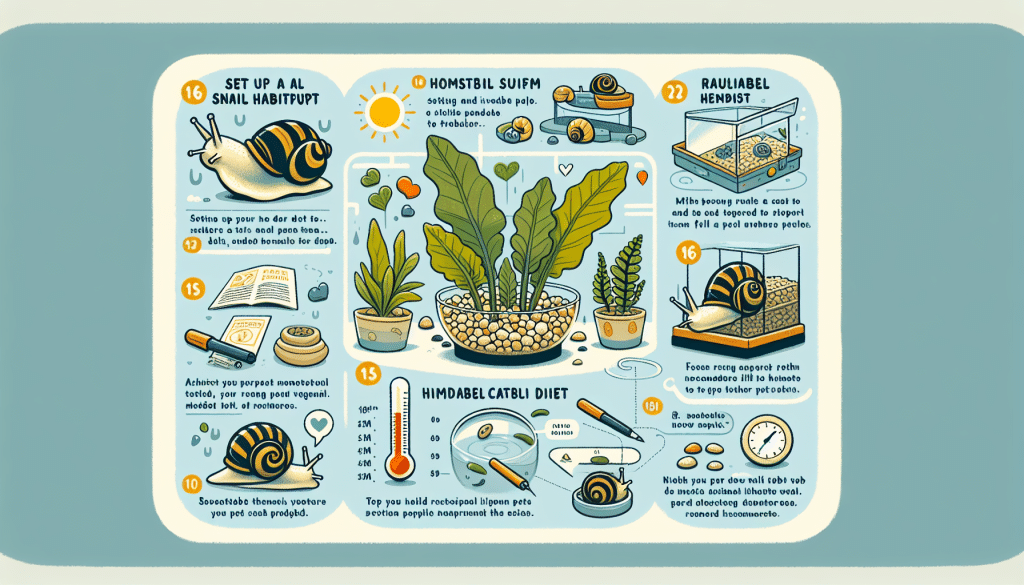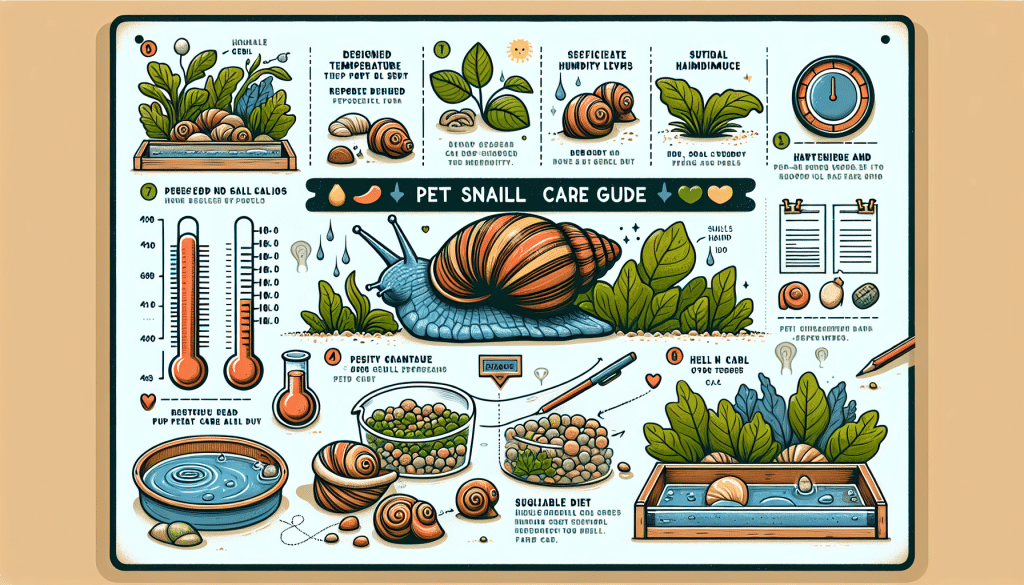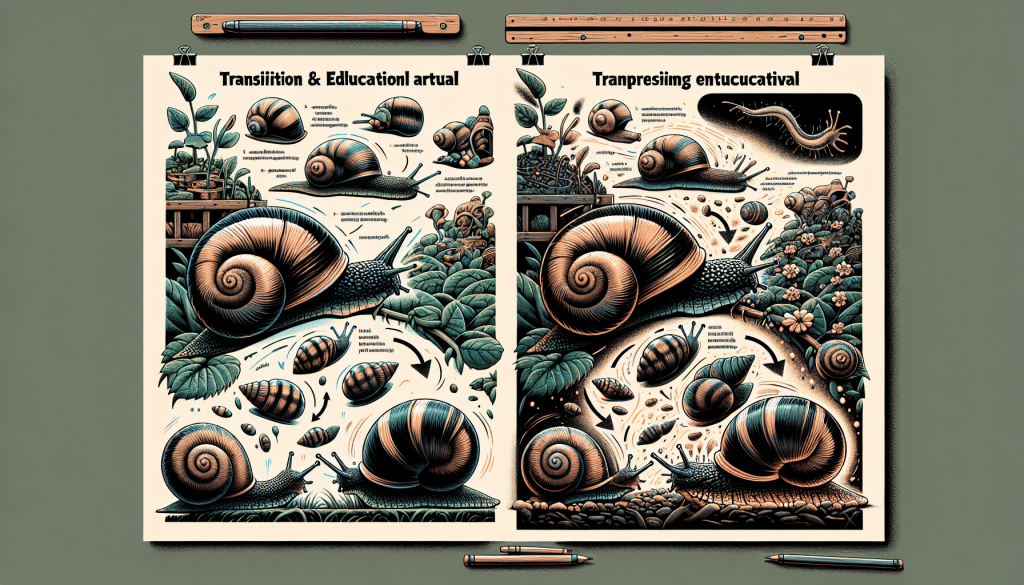So you’ve decided to bring a couple of cute and quirky pet snails into your life? Well, get ready to enter the fascinating world of snail keeping! Taking care of pet snails may seem like a breeze, but there are a few important things to keep in mind to ensure their happiness and well-being. In this article, we’ll provide you with some valuable tips on how to create a suitable habitat, feed your snails properly, and elevate your snail-keeping game to the next level. Get ready to embark on a journey that will surely enchant both you and your new slimy companions!

Understanding Snail Basics
Types of pet snails
When it comes to choosing a pet snail, there are a variety of options available. Some popular pet snail species include garden snails (Helix aspersa), Roman snails (Helix pomatia), and milk snails (Otala lactea). Each species has its own unique characteristics, such as shell color and pattern, size, and preferred habitat. It’s important to research the specific needs and requirements of the snail species you are interested in before bringing one home as a pet.
Snail lifespan
Snails are known for their longevity, with some species living up to 15 years or more in captivity. The lifespan of a pet snail can vary depending on factors such as species, diet, habitat conditions, and overall care. By providing proper care and meeting their needs, you can ensure that your snail lives a long and healthy life.
Snail behaviors and habits
Snails are fascinating creatures with unique behaviors and habits. They are nocturnal creatures, meaning they are most active during the night. During the day, snails usually retreat into their shells or find a sheltered spot in their habitat to rest. Snails are also known for their slow movement, as they navigate their environment using a muscular foot and a layer of mucus that helps them glide across surfaces. Observing and understanding these behaviors will allow you to better provide for your snail’s needs.
Setting Up the Snail Habitat
Choosing an appropriate terrarium or tank
When selecting a habitat for your pet snail, it’s important to choose a tank or terrarium that provides enough space for them to crawl and explore. A terrarium with a ventilation system is ideal to ensure proper airflow. The size of the habitat will depend on the number and size of snails you plan to keep. Additionally, make sure the habitat has a secure lid to prevent escapes and protect your snail from potential predators.
Proper substrate materials
The substrate or bedding in your snail’s habitat should mimic their natural environment and provide a comfortable surface for them to move on. Avoid using materials that are sharp or abrasive, as these can harm your snail’s delicate foot. Good options for substrate include coconut fiber, peat moss, or a mix of soil and sand. Make sure the substrate is kept moist, as snails require a humid environment to thrive.
Optimal temperature and humidity conditions
Snails are sensitive to extreme temperatures and require a specific range to ensure their well-being. The ideal temperature for most pet snails is between 68-78°F (20-25°C). It’s important to monitor the temperature in the habitat using a thermometer and make adjustments if necessary. Additionally, snails thrive in high humidity environments, with levels between 70-80% being ideal. Maintaining proper temperature and humidity conditions will promote a healthy and happy snail.
Providing hiding spots and climbing materials
Snails enjoy having hiding spots in their habitat where they can retreat and feel secure. You can provide various options such as small caves, pieces of bark, or even small flower pots turned on their side. These hiding spots will help reduce stress and provide a sense of security for your pet snail. Additionally, adding climbing materials such as small branches or pieces of cork bark will allow your snail to explore and exhibit its natural behavior of climbing.

Feeding Your Snail
Understanding snail dietary needs
Snails are herbivores, meaning they primarily feed on plant matter. Their diet should consist of a variety of fresh, leafy greens and vegetables. It’s important to ensure that the food provided is clean and free from pesticides or other harmful chemicals. Snails also require a source of calcium to maintain a healthy shell, so incorporating calcium-rich foods into their diet is essential.
Common foods suitable for snails
Some common foods that are suitable for snails include lettuce, spinach, kale, cucumber, zucchini, and carrots. These vegetables should be finely chopped or shredded to make them easier for your snail to consume. Additionally, you can offer occasional treats such as small pieces of fruit or commercially available snail foods.
How often to feed your snail
Snails have a slow metabolism and do not require large quantities of food. Feeding your snail every other day is generally sufficient. It’s important not to overfeed, as uneaten food can spoil and create an unsanitary environment for your snail. Observing your snail’s eating habits will give you an idea of its appetite and allow you to adjust the feeding schedule accordingly.
Supplements and nutrients required
In addition to a well-balanced diet, snails may require additional supplements to ensure they receive all the necessary nutrients. Calcium supplements, such as powdered cuttlebone or crushed eggshells, can be sprinkled on their food to provide the necessary calcium for shell growth and maintenance. It’s important to consult with a veterinarian or knowledgeable source to determine the appropriate supplementation for your specific snail species.
Hydration and Misting
Importance of hydration for snails
Proper hydration is crucial for the health and well-being of your pet snail. Snails obtain hydration from the food they eat, as well as from the moisture in their environment. Dehydration can lead to serious health issues and can even be fatal for snails. Ensuring a consistently humid environment and providing a water source will help keep your snail hydrated and prevent dehydration.
Creating a misting schedule
To maintain the appropriate humidity levels, misting the habitat regularly is necessary. Snails require high humidity, so misting the tank with water from a spray bottle once or twice a day is generally sufficient. The goal is to create a moist environment without over-saturating the substrate. Monitor the humidity levels using a hygrometer and adjust misting frequency if needed.
Avoidance of over-humidification
While it is important to provide a humid environment for your snail, over-humidification can lead to issues such as mold growth and respiratory problems for both the snail and the owner. Ensure that the tank has proper ventilation to allow for airflow and prevent excessive moisture buildup. Use a hygrometer to monitor humidity levels and make adjustments as necessary to maintain a healthy balance.

Maintaining the Habitat Cleanliness
How often to clean the tank
Regular cleaning of the snail’s habitat is essential to maintain a clean and healthy environment. Depending on the size of the tank and the number of snails, a thorough cleaning should be done every two to four weeks. However, it’s important to remove any uneaten food, snail waste, or other debris on a daily basis to prevent the buildup of harmful bacteria.
Proper cleaning materials to use
When cleaning the snail’s habitat, it’s important to avoid using harsh chemicals or cleaners as they can be toxic to snails. Instead, use mild, unscented soap or a vinegar-water solution to clean the tank. Rinse all cleaning products thoroughly to ensure no residue remains that could harm your snail.
Avoiding harmful chemicals
Snails are sensitive to chemicals and should not be exposed to cleaning products, pesticides, or other substances that can harm them. It’s important to be vigilant in keeping any potentially harmful substances away from the snail’s habitat. Avoid using chemical sprays or pesticides near the habitat, as these can be absorbed through their skin and cause serious harm.
Disposing of uneaten food and waste
Proper disposal of uneaten food and snail waste is necessary to maintain a clean and hygienic environment for your pet. Remove any uneaten food promptly, as it can quickly decompose and become a breeding ground for bacteria. Snail waste can be removed using a small scoop or a spoon. Dispose of both food and waste in a sealed bag and place it in the trash to avoid attracting pests.
Monitoring Snail Health
Common signs of a healthy snail
Being able to identify signs of a healthy snail is important for ensuring your pet’s well-being. A healthy snail should have a smooth, intact shell, clear and bright eyes, and a moist foot. It should be active during the night, exploring its environment and feeding regularly. Additionally, a healthy snail will have a healthy appetite and show an interest in its surroundings.
Symptoms of illness
When a snail is sick, it may display certain symptoms that indicate an underlying health issue. Some common signs of illness in snails include shell damage, discoloration, weight loss, sluggishness, loss of appetite, excessive mucus production, or any changes in behavior. If you notice any of these symptoms, it’s important to consult with a veterinarian experienced in exotic pets to determine the appropriate course of action.
What to do if your snail is sick
If you suspect that your snail is sick, it’s important to act promptly to address its health concerns. Remove the snail from its habitat and place it in a separate, quarantine tank to prevent the spread of potential infections. Consult with a veterinarian who specializes in snail care for an accurate diagnosis and appropriate treatment options.
Preventative care measures
Prevention is key when it comes to maintaining your snail’s health. Providing a proper diet, maintaining optimal habitat conditions, and practicing good hygiene in the snail’s environment are all important preventative care measures. Regularly monitoring your snail’s behavior, appetite, and appearance will allow you to detect any potential health issues early on and take appropriate action.

Socializing and Handling Snails
Snails’ social behaviors
While snails may not exhibit social behaviors in the same way that dogs or cats do, they can still benefit from positive interactions with their owners. Snails are aware of their surroundings and can become familiar with their owner’s presence and voice. Talking to your snail gently and spending time near its habitat can help establish a bond and make it feel more comfortable in its environment.
How to safely handle a snail
Snails are delicate creatures, and special care should be taken when handling them to avoid causing harm. To handle a snail, wet your hands slightly to prevent your skin from absorbing moisture from the snail’s foot. Gently pick up the snail, avoiding its sensitive body parts, and hold it with a gentle and steady grip. It’s important to always wash your hands before and after handling a snail to minimize the risk of transmitting any bacteria or parasites.
Interactions with other pets
If you have other pets in your home, it’s important to consider their interactions with your pet snail. Some pets, such as cats or dogs, may be curious about the snail or view it as prey. Keep your snail’s habitat in an area where it is safe from any potential harm or disturbances caused by other pets. Always supervise interactions and provide a secure lid or barrier to prevent accidents.
Understanding when your snail needs ‘alone time’
Just like any other living creature, snails need time to rest and recharge. While it can be entertaining to watch and interact with your snail, it’s important to recognize when it needs some quiet time. If your snail retreats into its shell or remains motionless for extended periods, it’s best to leave it alone and allow it to rest. Respecting your snail’s need for solitude will contribute to its overall well-being.
Breeding and Lifecycle
Understanding snails’ breeding habits
Snails are hermaphrodites, meaning they possess both male and female reproductive organs. To reproduce, two snails must mate and exchange sperm. After mating, each snail will lay eggs, typically in a humid area or in the substrate of their habitat. It’s important to note that not all snails will reproduce, and in some cases, specific conditions or environmental cues may be required to initiate breeding.
Raising baby snails
If your snails successfully reproduce, it’s important to provide appropriate care for the baby snails. The eggs will usually hatch in a few weeks, and the baby snails will emerge. It’s important to provide a separate tank or enclosure for the baby snails to prevent them from being preyed upon or accidentally injured by adult snails. Offer them a diet suitable for their size and age, including finely chopped vegetables and calcium supplements.
Maintaining different snail age groups in the same tank
Keeping snails of different ages in the same tank can present some challenges. Adult snails may unintentionally harm or even consume younger snails. To avoid this, it’s best to separate snails of different age groups into their own tanks until they are large enough to coexist safely. This will help ensure the well-being of all snails and prevent any unnecessary harm.
Lifespan stages of a snail
Snails go through various stages of development throughout their lifespan. After hatching, they start as tiny hatchlings and gradually grow into juveniles. As they continue to grow, they become subadults, and eventually, they reach their fully adult size. Each stage comes with its own unique needs and requirements, such as diet, hiding spots, and climbing materials. Understanding and providing for the different stages of a snail’s life will contribute to its overall health and well-being.

Potential Problems and Solutions
Preventing and treating common snail ailments
Snails are generally hardy creatures, but they can still encounter health issues that require attention. Some common ailments include shell damage, bacterial or fungal infections, mucus accumulation, or nutritional deficiencies. Providing a clean and hygienic environment, feeding a balanced diet, and monitoring their overall health will help prevent many issues. If health problems arise, consulting with a veterinarian experienced in snail care is recommended to determine the appropriate treatment.
Dealing with snail pests or parasites
Just like any other pet, snails can be susceptible to pests and parasites. Common pests include mites, flies, and worms that can infest their habitat or attach themselves to their shells. Regularly inspecting the snail’s habitat and observing any changes in their behavior can help identify potential pest or parasite problems. If an infestation is present, it’s important to take appropriate steps to eradicate the pests while ensuring the safety and well-being of the snail.
Handling a deceased snail
Losing a pet snail can be emotional, and knowing how to handle the situation is important. If your snail passes away, it’s best to remove the body from the habitat as soon as possible to prevent any potential health issues. You can bury the snail, or if you prefer, you can place it in a sealed bag and dispose of it in the trash. Take the time to grieve the loss and consider any necessary adjustments to your pet care routine or habitat conditions.
Addressing common behavior issues
Snails can exhibit various behavior issues, such as excessive retraction into their shells, lack of appetite, or abnormal mucus production. These behaviors can be indicative of underlying health problems or stressors in their environment. It’s important to assess the snail’s habitat conditions, diet, and overall care routine to identify any potential triggers. Making necessary adjustments or seeking guidance from a veterinarian will help address and resolve behavior issues.
Additional Snail Care Tips
Choosing healthy snails to adopt
When adopting a pet snail, it’s important to choose one that appears healthy and active. Look for snails with intact shells, clear eyes, and a moist foot. Avoid snails that show signs of illness, such as lethargy, abnormal mucus production, or shell damage. Additionally, make sure the snail comes from a reputable source that practices proper care and husbandry.
Creating a stress-free environment
Snails can be sensitive to stress, and a stressful environment can negatively impact their health and well-being. Avoid sudden changes in temperature or humidity levels, loud noises, or excessive handling, which can all contribute to stress. Provide a calm and quiet environment for your snail and keep interactions gentle and low-key.
Importance of a regular care routine
Establishing a regular care routine is essential for the well-being of your pet snail. This includes feeding them at consistent intervals, monitoring their behavior and appearance, maintaining proper habitat conditions, and cleaning the tank regularly. Consistency in providing care will help your snail feel secure and minimize any potential stressors.
Educating others about proper snail care
Snails are often misunderstood pets, and many people are unaware of their unique care requirements. Educating others about proper snail care can help dispel myths and misconceptions while promoting responsible pet ownership. Share your knowledge and experiences with others, and encourage them to research and learn more about snail care before considering them as pets.
Taking care of pet snails can be a rewarding experience. By understanding their basic needs, setting up a suitable habitat, providing proper nutrition and hydration, maintaining cleanliness, monitoring their health, and handling them safely, you can ensure that your pet snail lives a happy and healthy life. Remember, each snail is unique, so it’s important to observe and adapt to their individual needs to provide the best care possible.


